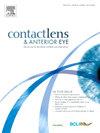佩戴矫形角膜接触镜在减缓儿童眼轴伸长方面的安全性。
IF 3.7
3区 医学
Q1 OPHTHALMOLOGY
引用次数: 0
摘要
目的:评估佩戴角膜塑形镜在减缓近视儿童眼轴伸长方面的安全性:方法:汇集三项前瞻性研究的安全性数据进行分析,这三项研究评估了使用角膜塑形镜延缓儿童近视发展的情况,并与单视力眼镜佩戴者组成的平行对照组进行了为期两年的对比。主要和次要安全性终点分别是正视角膜塑形镜组和对照组之间不良事件和裂隙灯检查结果≥2级的比较:本研究共分析了 125 名角膜矫形者和 118 名对照组受试者的数据。其中,101 名(81%)和 88 名(75%)正角膜治疗者和对照组受试者分别完成了为期两年的随访。19名角膜矫形术受试者出现了28次不良反应,其中6次为严重不良反应,而对照组受试者仅出现了1次不良反应;这一差异具有统计学意义(P 0.05):结论:佩戴隔夜角膜塑形镜一年内,约有 13% 的眼睛可能会出现不良反应,如果仅考虑与镜片相关的不良反应,这一数字会更低。没有发现严重的不良事件,大多数都不严重。这些结果为眼科护理人员提供了信息,使他们了解到矫形角膜塑形镜在减缓近视儿童近视度数加深方面的安全性。本文章由计算机程序翻译,如有差异,请以英文原文为准。
The safety of orthokeratology contact lens wear in slowing the axial elongation of the eye in children
Purpose
To evaluate the safety of orthokeratology contact lens wear in slowing the axial elongation of the eye in myopic children.
Methods
Safety data from three prospective studies, which evaluated the use of orthokeratology for slowing myopia progression in children in comparison to a parallel control group of single-vision spectacle lens wearers over a 2-year period, were pooled together for analysis. The primary and secondary safety endpoints are the comparisons of adverse events and slit-lamp findings grades ≥ 2 between orthokeratology and control groups, respectively.
Results
Collectively, data from 125 orthokeratology and 118 control subjects were analyzed in this study. Of these, 101 (81 %) and 88 (75 %) orthokeratology and control subjects completed the 2-year follow-up period, respectively. Nineteen orthokeratology subjects experienced 28 adverse events, of which 6 were significant, whereas just one adverse event was found in the control group; this difference was statistically significant (p < 0.001). Most adverse events found in the orthokeratology group were corneal in nature, primarily corneal abrasion/staining, accounting for around 40 % of all adverse events. Of the 28 adverse events, only 18 (3 significant) are likely to be contact lens-related, leading to incidence rates of total and device-related adverse events per 100 patient years of lens wear (95 % confidence intervals) of 13.1 (9.2–18.2) and 8.4 (5.4–10.7), respectively. No significant differences were found between groups in the total number of silt-lamps findings with grades ≥ 2 (p > 0.05).
Conclusion
Around 13% of eyes wearing overnight orthokeratology contact lenses are likely to experience an adverse event over one year of lens wear, with this figure being lower when considering device-related adverse events alone. No serious adverse events were found, with most being non-significant. These results inform eye care practitioners on the safety of orthokeratology lenses when prescribed for slowing myopia progression to myopic children.
求助全文
通过发布文献求助,成功后即可免费获取论文全文。
去求助
来源期刊

Contact Lens & Anterior Eye
OPHTHALMOLOGY-
CiteScore
7.60
自引率
18.80%
发文量
198
审稿时长
55 days
期刊介绍:
Contact Lens & Anterior Eye is a research-based journal covering all aspects of contact lens theory and practice, including original articles on invention and innovations, as well as the regular features of: Case Reports; Literary Reviews; Editorials; Instrumentation and Techniques and Dates of Professional Meetings.
 求助内容:
求助内容: 应助结果提醒方式:
应助结果提醒方式:


